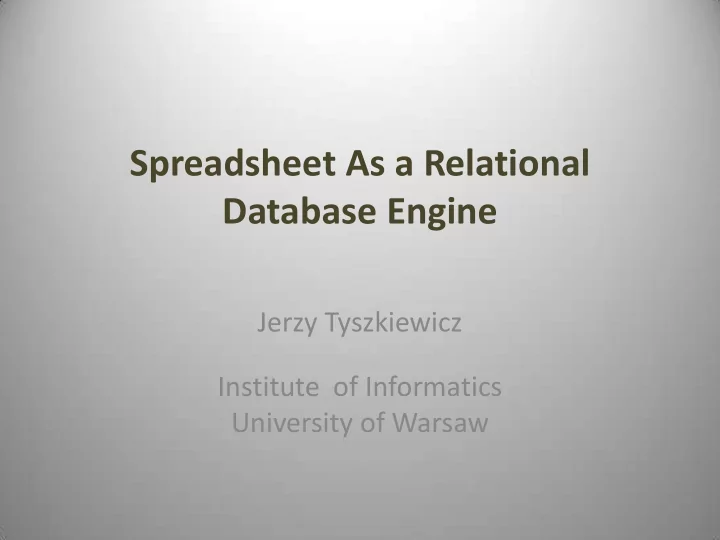

Spreadsheet As a Relational Database Engine Jerzy Tyszkiewicz Institute of Informatics University of Warsaw
In the beginning there was data … Incomes firstname name income Les Brown £1 230,00 John Brown £1 090,00 Terry Jones £770,00 Lisa Taylor £1 570,00 Megan Smith £0,00 John Brown £2 200,00 Clara Jones £900,00 Phil Smith £300,00 Joe Brown £0,00 Ted Jones £150,00 Alex Willis £2 130,00 Carol Jones £3 030,00 Elise Smith £1 200,00 Jonathan Brown £0,00 Susan Willis £0,00 Joe Jones £2 500,00 Caspar Smith £100,00 … … …
…and a query… SELECT name, AVG(income) FROM Incomes GROUP BY name HAVING COUNT(*)>3
…and a user I want to do that in a spreadsheet! • I know Excel , I do not know Access • MS Office with Access is more expensive • There are no databases on the cloud • I’m afraid of real big databases Illustration ChrisL_AK, Flickr
Bill Gates spoke about that user … A lot of users today find the true databases complex enough that they simply go into either the word processor, with the table-type capabilities, or into the spreadsheet, which I'd say is a little more typical, and use that as their way of structuring data. And, of course, you get a huge discontinuity because, as you want to do database-type operations, the spreadsheet isn't set up for that. And so then you have to learn a lot of new commands and move your data into another location.
…i n his keynote speach at SIGMOD ‘98 What we'd like to see is that even if you start out in the spreadsheet, there's a very simple way then to bring in software that uses that data in a richer fashion, and so you don't see a discontinuity when you want to move up and do new things. But that's very easy to say that. It's going to require some breakthrough ideas to really make that possible.
Google spreadsheet can do that • SQL-like syntax • comfortable interface but • no HAVING clause • no JOIN • no UNION, EXCEPT
Then there was more data… Incomes Families id firstname income id name 1 Les £1 230,00 1 Brown 3 John £1 090,00 2 Smith 1 Terry £770,00 3 Smith 4 Lisa £1 570,00 4 Jones 2 Megan £0,00 5 Taylor 5 John £2 200,00 6 Willis 6 Clara £900,00 … … 1 Phil £300,00 2 Joe £0,00 4 Ted £150,00 6 Alex £2 130,00 1 Carol £3 030,00 2 Elise £1 200,00 3 Jonathan £0,00 6 Susan £0,00 3 Joe £2 500,00 5 Caspar £100,00 … … … … … …
…and another query… SELECT Families.id,Families.name,AVG(Incomes.income) FROM Families JOIN Incomes ON Families.id=Incomes.id GROUP BY Families.id,Families.name HAVING COUNT(*)>3
…and still the same user I want that again in a spreadsheet! Illustration ChrisL_AK, Flickr
Can spreadsheets do that? • Google spreadsheet can do that! • And OpenOffice ! • And gnumeric ! • And Excel ! • And almost every other spreadsheet, too!
General theory Theorem Every query in Relational Algebra can be implemented in a spreadsheet. Also every query in SQL can be implemented in a spreadsheet.
Main theoretical contribution Spreadsheets can: • store relational data • execute SQL queries Therefore: Spreadsheets are relational database engines
Performance in Excel time in seconds many-to-many join many-to-one join no join no Families size of Incomes in thousands
Main practical contributions in answer to Bill Gates ( Excel ) • Spreadsheets can serve as low-end relational database engines • Small databases of a few thousand tuples can be used in practice • A method to offer databases on the cloud
Suggestions • Elements of database methodology can be transferred to the spreadsheet design • Need of optimization of certain spreadsheet functions
Related research • Filling the gap between spreadsheets and databases from the database direction • We fill that gap from the spreadsheet direction
Thank you!
Recommend
More recommend